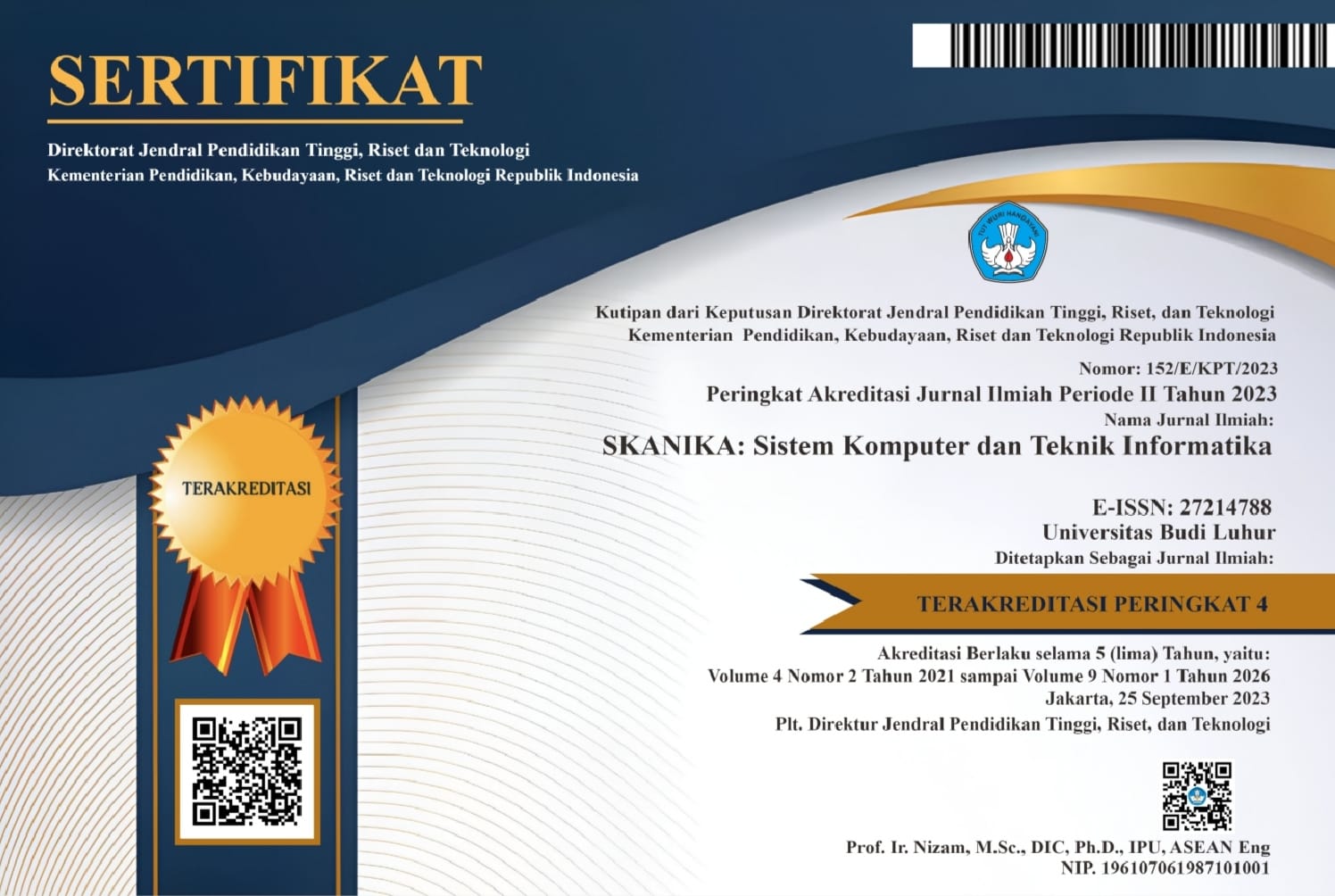CONVOLUTIONAL NEURAL NETWORK (CNN) UNTUK KLASIFIKASI CITRA PENYAKIT DIABETES RETINOPATHY
Abstract
Diabetic Retinopathy (DR) merupakan suatu komplikasi yang terjadi karena adanya kerusakan pada pembuluh darah retina. DR melalui citra retina mata sudah pernah diteliti menggunakan proses peningkatan kualitas citra maupun teknik filtering. Citra DR, memiliki garis tebal dan tipis pada citra fundus dimana tebal tipisnya digunakan untuk menentukan apakah citra fundus tersebut terkategori sebagai citra DR. Biasanya, teknik filtering diperlukan dalam mempertajam garis pada citra fundus. Pada penelitian ini, optimasi dalam klasifikasi citra retina mata yang terdiagnosa retinopati telah dilakukan menggunakan algoritma Convolutional Neural Network (CNN) dengan tujuan pengenalan pembuluh darah pada retina mata terdiagnosa DR. Urgensi dari penelitian ini yaitu melakukan uji performa CNN dalam proses klasifikasi citra DR pada jumlah data yang cukup besar tanpa menggunakan preprosesing apapun sehingga dapat disimpulkan bahwa CNN saja sudah mampu mengklasfikasi objek dengan baik. Citra berasal dari Kaggle database dengan total 88702 citra yang di sortir menjadi 88000 data. Hasil klasifikasi citra benar yaitu 82445 dengan prosentse 93,68% sedangkan citra salah klasifikasi yaitu 5555 citra dengan prosentase kegagalan yaitu 6,32%.
Downloads
References
[2] M. D. Abràmoff et al., “Improved automated detection of diabetic retinopathy on a publicly available dataset through integration of deep learning,” Investig. Ophthalmol. Vis. Sci., vol. 57, no. 13, pp. 5200–5206, 2016.
[3] W. L. Alyoubi, W. M. Shalash, and M. F. Abulkhair, “Diabetic retinopathy detection through deep learning techniques: A review,” Informatics Med. Unlocked, vol. 20, p. 100377, 2020.
[4] M. Iglicki, D. Zur, and A. Loewenstein, “Detection of diabetic retinopathy using deep learning analysis,” Retin. Today, vol. 2021, September, pp. 42–46, 2021.
[5] R. Ghosh, K. Ghosh, and S. Maitra, “Automatic detection and classification of diabetic retinopathy stages using CNN,” 2017 4th Int. Conf. Signal Process. Integr. Networks, SPIN 2017, pp. 550–554, 2017.
[6] B. Tymchenko, P. Marchenko, and D. Spodarets, “Deep learning approach to diabetic retinopathy detection,” ICPRAM 2020 - Proc. 9th Int. Conf. Pattern Recognit. Appl. Methods, pp. 501–509, 2020.
[7] S. Aulia, S. Hadiyoso, and D. N. Ramadan, “Analisis Perbandingan KNN dengan SVM untuk Klasifikasi Penyakit Diabetes Retinopati berdasarkan Citra Eksudat dan Mikroaneurisma,” ELKOMIKA J. Tek. Energi Elektr. Tek. Telekomun. Tek. Elektron., vol. 3, no. 1, p. 75, 2015.
[8] K. Xu, D. Feng, and H. Mi, “Deep convolutional neural network-based early automated detection of diabetic retinopathy using fundus image,” Molecules, vol. 22, no. 12. 2017.
[9] D. U. N. Qomariah, H. Tjandrasa, and C. Fatichah, “Classification of diabetic retinopathy and normal retinal images using CNN and SVM,” Proc. 2019 Int. Conf. Inf. Commun. Technol. Syst. ICTS 2019, pp. 152–157, 2019.
[10] M. Raju, V. Pagidimarri, R. Barreto, A. Kadam, V. Kasivajjala, and A. Aswath, “Development of a deep learning algorithm for automatic diagnosis of diabetic retinopathy,” Stud. Health Technol. Inform., vol. 245, pp. 559–563, 2017.
[11] S. Roychowdhury, D. D. Koozekanani, and K. K. Parhi, “DREAM: Diabetic Retinopathy Analysis Using Machine Learning,” IEEE J. Biomed. Heal. Informatics, vol. 18, no. 5, pp. 1717–1728, 2014.
[12] P. Samant and R. Agarwal, “Machine learning techniques for medical diagnosis of diabetes using iris images,” Comput. Methods Programs Biomed., vol. 157, pp. 121–128, Apr. 2018.
[13] A. Mahmood, M. Bennamoun, S. An, F. Sohel, and F. Boussaid, “ResFeats: Residual network based features for underwater image classification,” Image Vis. Comput., vol. 93, Jan. 2020.
[14] D. M. Mahalakshmi and S. Sumathi, “Brain Tumour Segmentation Strategies Utilizing Mean Shift Clustering and Content Based Active Contour Segmentation,” ICTACT J. Image Video Process., vol. 9, no. 4, pp. 2002–2008, 2019.
[15] N. Ani Brown Mary and D. Dharma, “Coral reef image classification employing Improved LDP for feature extraction,” Journal of Visual Communication and Image Representation, vol. 49. Academic Press Inc., pp. 225–242, 01-Nov-2017.
[16] M. J. Schaap, N. J. Cardozo, A. Patel, E. M. G. J. de Jong, B. van Ginneken, and M. M. B. Seyger, “Image-based automated Psoriasis Area Severity Index scoring by Convolutional Neural Networks,” J. Eur. Acad. Dermatology Venereol., vol. 36, no. 1, pp. 68–75, Jan. 2022.
[17] J. Amin, M. Sharif, N. Gul, M. Yasmin, and S. A. Shad, “Brain tumor classification based on DWT fusion of MRI sequences using convolutional neural network,” Pattern Recognit. Lett., vol. 129, pp. 115–122, Jan. 2020.
[18] H. Shah, R. Rajasekaran, and J. Masih, “A Comparative Study of Classification Algorithms with Varying Training Dataset Sizes on Cursive Hiragana Characters,” J. Xi’an Univ. Archit. Technol., vol. XII, no. Viii, pp. 1388–1396.
[19] S. Mishra, R. Sachan, and D. Rajpal, “Deep Convolutional Neural Network based Detection System for Real-time Corn Plant Disease Recognition,” Procedia Comput. Sci., vol. 167, pp. 2003–2010, 2020.
[20] I. Gogul and V. S. Kumar, “Flower species recognition system using convolution neural networks and transfer learning,” 2017 4th Int. Conf. Signal Process. Commun. Networking, ICSCN 2017, pp. 1–6, 2017.
[21] H. Riaz, et al, “Deep and densely connected networks for classification of diabetic retinopathy,” Diagnostics, vol. 10, no. 1. pp. 1-15, 2020.
[22] A. Krizhevsky, I. Sutskever, and G. E. Hinton, “ImageNet classification with deep convolutional neural networks,” Commun. ACM, vol. 60, no. 6, pp. 84–90, 2017.












